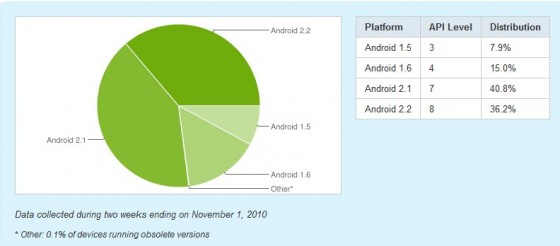Month after month, quarter after quarter, I see the infamous pie chart of where the various versions of the Android operating systems are sitting. Every time I see the percentages changing toward 2.1 and 2.2 I can only help but wonder about two questions.
- How much of that percentage is based off of custom ROM access?
- How many OEM/Carriers are contributing to the slowness of updates?
Those two questions are relatively important. Sadly there is not a lot of data on either of these two topics. Take a look at the most recent update through November 1st. The following pie chart and table is based on the number of Android devices that have accessed Android Market within a 14-day period ending on the data collection date noted below.
 Here we have a nice little chart showing the percentage of various Android OS’s being used. To the general reviewer of this information, nothing seems to be off. I highlighted the most important part of the information that gets me wondering so much. The number of Android devices that have accessed Android Market. What this means is that the number of devices running any specific Android OS’s is calculated by which version of the the Android market registers it as. Makes sense. At the same time though the numbers are flawed. Let’s think about why. Team Douche, to name one of the amazing developer teams out there, not too long ago, stated that CyanogenMOD 6.0 was downloaded over 250,000 times. If for some reason you aren’t aware of what CyanogenMOD is then let me explain. The team is responsible for bringing custom 2.1 and 2.2 ROMs to devices such as the My Touch 3G, T-Mobile G1, HTC Hero, HTC Aria and a few other devices out there that started out on less then Android 2.2 and are currently only on a newer OS because of these developers.
Here we have a nice little chart showing the percentage of various Android OS’s being used. To the general reviewer of this information, nothing seems to be off. I highlighted the most important part of the information that gets me wondering so much. The number of Android devices that have accessed Android Market. What this means is that the number of devices running any specific Android OS’s is calculated by which version of the the Android market registers it as. Makes sense. At the same time though the numbers are flawed. Let’s think about why. Team Douche, to name one of the amazing developer teams out there, not too long ago, stated that CyanogenMOD 6.0 was downloaded over 250,000 times. If for some reason you aren’t aware of what CyanogenMOD is then let me explain. The team is responsible for bringing custom 2.1 and 2.2 ROMs to devices such as the My Touch 3G, T-Mobile G1, HTC Hero, HTC Aria and a few other devices out there that started out on less then Android 2.2 and are currently only on a newer OS because of these developers.
So I wonder how much of a percentage is actually FALSE, due to the excellent work of the Android community? I am not saying that the numbers would sway in a huge way. I still think we should be able to take into account the custom work that is being done to bring us these updated OS’s versions. After all, the developers are helping to make Google’s charts bring 2.1 and 2.2 to the top of the list. Does anyone out there have any solid numbers that we can attribute to this at all?
The second question dives into the responsibility of the OEM’s/Carriers. They are the sole reason that your phone has not received that much needed and wanted OS update. Yes, I am directly blaming them for all our woes. Let me explain why I feel this way and know it to be true.
We can very easily start out with the Nexus One. Every update that Google has and will ever make will be rolled out to that device before anyone else will ever see it. This is simply because Google made the phone with HTC how they thought and think a phone should be made: with no bloat ware, no carrier specific applications and no OEM/Carrier custom UI. Simple, powerful, useful and nearly perfect. Although the overall sales of the device were not what Google had thought they could or should be, it still sold well. This doesn’t prove anything yet though does it?
So we move on. Let’s take a look at one of the newer devices launched. How about the Samsung Galaxy S series of devices. The original release date for this device was late July. Froyo from Google became available in June. So we can all understand that a phone that was in production already for all the major U.S. carriers would not launch with 2.2. I can understand that. One thing I do remember Samsung saying though was how minimally integrated Touch Wiz was to make updates easier and faster to achieve for the consumers. Here we are in the end of November and still no update. Not officially anyways. The I9000 in the UK got their update. I know the Fascinate has one close at hand. With the Touch Wiz UI being “minimally integrated”, whats the hold up? How can such a huge company take so long to bring 2.2 to the supposed largest internationally launched device to date? The device that they want to see go “Diamond” by the end of the year. This directly ties back into the OEM’s/Carriers continuing their reign of fragmentation control.
What incentive does Samsung have to move all the devices they have put out there to 2.2 when they are supposedly the makers of the Samsung Nexus S running 2.3? Why on earth would a carrier like T-Mobile want to take the 2.2 software and add their bloat ware to it when they really want you to buy the G2 or the MyTouch 4G instead?
We could spend another hour or more discussing the multiple failures that exist in the industry we have grown to reluctantly accept. I won’t do that to you. You as the consumer can see who and where all this frustration comes from. They advise against ROOT and custom ROM’s but in the end it’s the only way for us to have the software that we should have already had on our $500 devices that most of us are still paying off.
The solution to this situation is simple. If a carrier simply launched amazingly built phones with amazing hardware and keep the devices good old Vanilla Android we would be headed in the right direction. From there they build their custom UI and release it into the market. Not for free, but for a price. For illustration purposes only say, 100,000 phones sold with Sense. But 500,000 people with different devices bought a Sense home replacement app in the market for 9.99 or even 19.99 Would they gain more money or lose money on their software?
We have seen specific applications become available for certain devices in the past. Would it be too terribly difficult for HTC to set it up that only an HTC device could purchase the software? Take it a step further, I buy a Samsung Vibrant but want the Sense UI. I am buying a Vibrant regardless, wouldn’t it be nice if HTC still made some money though. This could easily apply to a multitude of devices and UI’s.
If the OEM’s/Carriers paid attention to any of this we would have happier customers across multiple devices and multiple carriers. People will buy the device they like and go with the carrier they want. That will never change. Put them on the spot to actually make solid, unique and usable devices. Then they can consistently update the software for and keep the public happy.
Anyone else with me on any of this or am I just crazy?








